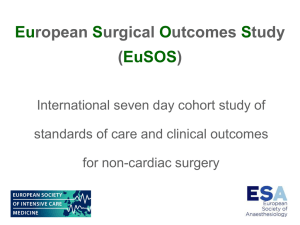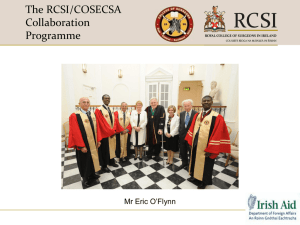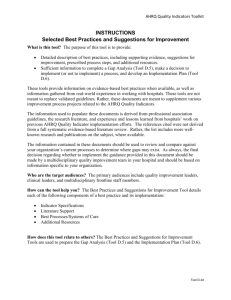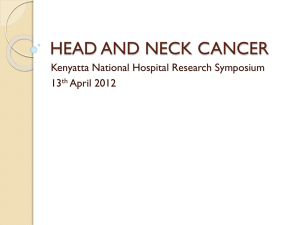Retained Foreign Bodies
advertisement
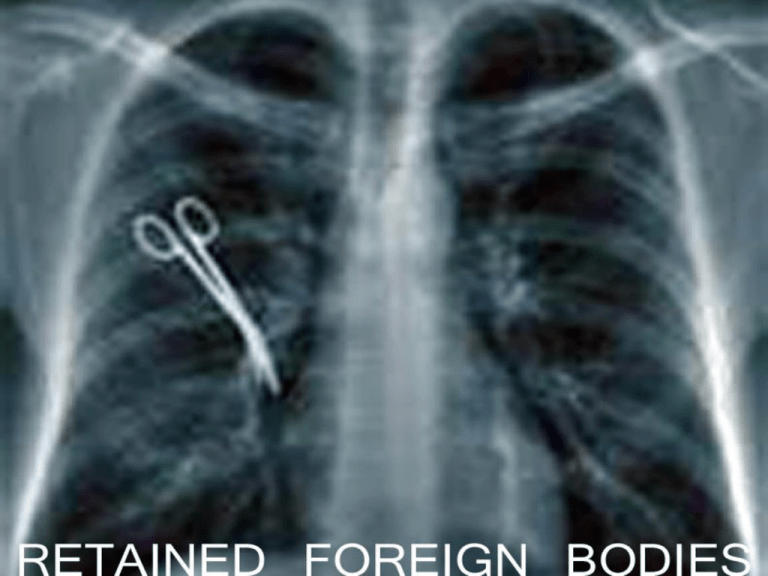
RETAINED FOREIGN BODY • In this case, a retained foreign body is an object, typically a surgical instrument, gauze or sponge, that has been left inside a patient during the surgery and not accounted for in the count at the end. • In 2009, the occurrence rate was “0.0031% or 1 in 32,672 cases” (Shah & Lander, 2009). RISK FACTORS FOR RETAINED FOREIGN BODIES • “Risk factors included a change in nursing personnel during surgery, excessive loss of blood, lack of complete count of sponges and instruments, fatigue of the surgical team from the lengthiness or lateness of the procedure and urgency of the surgery, obesity, unexpected intra-operative developments, the involvement of multiple surgical teams, and the performance of more than 1 major procedure at a time”(McLeod & Bohnen, 2004). • The 3 most important factors identified were: “emergency surgery, unplanned change in the operation, and body mass index” (McLeod & Bohnen, 2004). COUNTING During an operation, the counting of the instruments, gauze, and sponges is the duty of the circulating RN. COUNTING • The hospital’s Standards of Care as well as the Association of periOperative Registered Nurses (AORN) Recommended Standards of Practice provide an outline for the procedures involved in counting instruments and other items for surgery. COUNTING • Only sponges detectable with an X-ray can be used and should be counted once at the beginning and twice at the end of the surgical procedure. • Instrumentation should be counted for open cavity procedures, once at the beginning and once at the end of a surgical procedure. • If a sponge or instrument is unaccounted for in the final count, a radiological exam and manual exploration should be performed. (Erickson, 2003) COUNTING • One of the difficulties involved in counting is that there is no “standard” surgical kit. • Instruments, sponges, gauze all vary based on the surgery being conducted. • They can be of all shapes, sizes, and amounts. • Like in any setting, small objects or a large quantity of objects can be difficult to count without having an error. THEY CAN BE ANYWHERE Pie chart was made from figures obtained from a study of thirty cases by Lincourt et. al., 2007. THEY CAN BE ANYWHERE • Retained Foreign Bodies seem to appear more often in the Abdominal and Thoracic cavities than anywhere else in the body. • This can possibly be because more items, like sponges, tend to be used in these areas. • But, it is possible to be found in any area of the body that has been operated on. SYMPTOMS OF A RETAINED FOREIGN BODY • • • • • Infection Sepsis Bowel Perforation or Obstruction Internal Bleeding Abscesses • It is possible to have a retained foreign body and remain asymptomatic. POSSIBLE SOLUTIONS • Have at least one other person than just the circulating nurse count! – I.E. scrub nurse POSSIBLE SOLUTIONS • Formulate a detailed checklist of everything that will be used! POSSIBLE SOLUTIONS • There are specialized trays, but they can be further advanced. MY SOLUTION MY SOLUTION MY SOLUTION FEATURES • Tray has inlays in the shape of the instrument with notches to pick them out. • Would have bowls for sponges or gauze. • Counts the amount of objects present based on weight that has an adjustable tolerance to account for soiled materials • Has an “on/tare” function to set for prior to surgery. FEATURES • LED lights will be lit Green when all are accounted for, Red when missing something, Blue when there is more than what originally was there. • Digital Liquid Crystal Counter built in as back up to tell an exact amount present. • Will be made of materials that allow it to be autoclavable. WORKS CITED • Erickson, S. (2003). O.R. Left behind. Counting surgical instruments reduces medical errors. Materials Management In Health Care, 12(7), 32-34. • Lincourt, A. E., Harrell, A., Cristiano, J., Sechrist, C., Kercher, K., & Heniford, B. T. (2007). Retained foreign bodies after surgery. The Journal Of Surgical Research, 138(2), 170-174. • McLeod, R. S., & Bohnen, J. M. A. (2004). Canadian Association of General Surgeons Evidence Based Reviews in Surgery. 9. Risk factors for retained foreign bodies after surgery. [Article]. Canadian Journal of Surgery, 47(1), 57-59. • Shah, R. K., & Lander, L. (2009). Retained foreign bodies during surgery in pediatric patients: a national perspective. Journal Of Pediatric Surgery, 44(4), 738-742.




